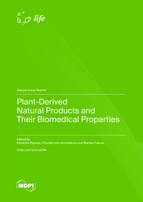Plant-Derived Natural Products and Their Biomedical Properties
A special issue of Life (ISSN 2075-1729). This special issue belongs to the section "Pharmaceutical Science".
Deadline for manuscript submissions: closed (23 June 2023) | Viewed by 26538
Special Issue Editors
Interests: diet; gut health; natural products; phytochemicals; inflammation; inflammatory bowel disease; oxidative stress
Special Issues, Collections and Topics in MDPI journals
Interests: biology; molecular nutrition; inflammation; phytochemicals; clinical trials; inflammatory diseases; obesity; epigenetics
Special Issues, Collections and Topics in MDPI journals
Interests: nanomedicine; natural compounds; drug-delivery; cancer research; electron microscopy analysis; multidrug resistance of tumor cells and microrganisms
Special Issue Information
Dear Colleagues,
We are very happy to announce a Special Issue entitled "Plant-Derived Natural Products and Their Biomedical Properties" that is being prepared for Life.
Plant-derived natural products have been well known since antiquity for their beneficial effects on human health and have been utilised in pain management, gut health, skin issues, etc. Since then, they have attracted the interest of the scientific community, leading to the identification, isolation and quantification of their compounds and the study of their biomedical properties. Plant-derived natural products have been found to be rich in phytochemicals, such as terpenes and phenolic compounds, with proven antioxidant, anti-inflammatory, antimicrobial, antitumor and prebiotic properties through numerous in vitro and in vivo studies. Therefore, they have been suggested as potential candidates for the therapeutic management of several chronic diseases including inflammatory bowel disease, diabetes, non-alcoholic fatty liver disease, arthritis and cancer, where inflammation, oxidative stress and dysbiosis mechanisms are implicated. Further, given the increased economic burden, the side effects and the low compliance rate of patients with standard medical treatments, plant-derived natural products could possibly serve as adjunct therapeutic agents for chronic diseases.
The aim of this Special Issue is to address recent advances in the research of plant-derived natural products, their mechanisms of action and how they can influence health and disease.
Experts interested in this Special Issue are invited to submit original manuscripts and reviews addressing the above-mentioned aspects.
Dr. Efstathia Papada
Dr. Charalampia Amerikanou
Prof. Dr. Marisa Colone
Guest Editors
Manuscript Submission Information
Manuscripts should be submitted online at www.mdpi.com by registering and logging in to this website. Once you are registered, click here to go to the submission form. Manuscripts can be submitted until the deadline. All submissions that pass pre-check are peer-reviewed. Accepted papers will be published continuously in the journal (as soon as accepted) and will be listed together on the special issue website. Research articles, review articles as well as short communications are invited. For planned papers, a title and short abstract (about 100 words) can be sent to the Editorial Office for announcement on this website.
Submitted manuscripts should not have been published previously, nor be under consideration for publication elsewhere (except conference proceedings papers). All manuscripts are thoroughly refereed through a single-blind peer-review process. A guide for authors and other relevant information for submission of manuscripts is available on the Instructions for Authors page. Life is an international peer-reviewed open access monthly journal published by MDPI.
Please visit the Instructions for Authors page before submitting a manuscript. The Article Processing Charge (APC) for publication in this open access journal is 2600 CHF (Swiss Francs). Submitted papers should be well formatted and use good English. Authors may use MDPI's English editing service prior to publication or during author revisions.
Keywords
- plant-derived natural products
- phytochemicals
- antioxidants
- inflammation
- therapeutic agent









